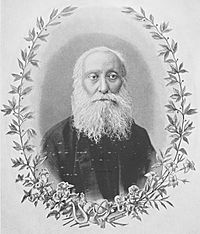Ghevont Alishan facts for kids
Quick facts for kids The Reverend Ghevont Alishan |
|
|---|---|

Portrait of Alishan from his 1901 book Hayapatum (Հայապատում, "Armenian History")
|
|
| Church | Catholic Church |
| Personal details | |
| Born | July 6, 1820 Constantinople, Ottoman Empire |
| Died | November 9, 1901 (aged 81) Venice, Kingdom of Italy |
| Nationality | Armenian |
| Denomination | Armenian Catholic |
| Residence | San Lazzaro degli Armeni |
Ghevont Alishan (Armenian: Հայր Ղեւոնդ Ալիշան) was an important Armenian Catholic priest, historian, and poet. He lived from 1820 to 1901. You might also see his name spelled as Ghevond Alishan. In Italian, he was called Leonzio Alishan, and in French, Léonce Alichan.
Alishan was recognized by many important groups for his work. He received the Legion of Honour from the French Academy in 1866. He was also an honorary member of the Asian Society of Italia, the Archeological Society of Moscow, the Venice Academy, and the Archeological Society of Saint-Petersburg.
The famous writer John Ruskin once said that he "always looked upon him Padre Alishan as a sort of saint." Ruskin added that Alishan had been his friend for many years.
Life and Work
Ghevont Alishan became a member of the Mekhitarist Congregation in 1838. This group is located on Saint Lazarus Island in Venice, Italy. From 1859 to 1861, he was the director of the Armenian College in Paris.
Designing the Armenian Flag
In 1885, Ghevont Alishan created the first modern design for the Armenian flag. His first idea was a flag with three horizontal stripes. The colors he chose were different from the Armenian flag we see today.
First Flag Design
Alishan's first flag design had a red top stripe. This color symbolized the first Sunday of Easter, which is called "Red" Sunday. The middle stripe was green, representing the "Green" Sunday of Easter. For the bottom stripe, he chose white to complete the look.
Second Flag Design
While he was in France, Alishan also designed a second flag. This design was inspired by the national Flag of France. Its colors were red, green, and blue. These colors represented the beautiful band of colors that Noah saw after his ark landed on Mount Ararat.
Legacy
A special statue, called a bust, of Ghevont Alishan was made in 1903. The sculptor who created it was Andreas Ter-Marukian. You can see this bust displayed in the National Gallery of Armenia.
Images for kids
See also
- Leonardo Alishan



